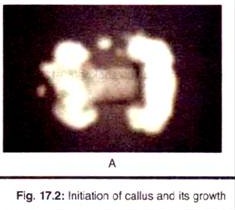In this article we will discuss about the initiation and maintenance of callus culture.
Callus culture represents clumps of unorganised parenchyma tissue formed through vigorous proliferation by cell division from any kind of explants under cultural condition, showing no polarity.
Any kind of permanent but living tissue such as parenchyma, collenchyma, cortical tissue, pith cells, phloem tissue, cambium cells or meristematic tissue may take part in callus formation. The permanent tissue cells become rejuvenated and the influence of endogenous or exogenously applied growth substances leads to the stimulation of cell division.
Initiation of Callus Culture:
Induction of cell division in the permanent tissue is highly dependent on the high auxin content (e.g., 2, 4-D) in the medium. The hormone requirement for callus induction may be auxin alone, cytokinin alone or auxin and cytokinin in different ratios. The type of growth regulator requirement and its concentration in the medium depends strongly on the genotype and endogenous hormone content of an explant.
Transformation of any kind of tissue explant into proliferating callus mass depends highly on the plant genotype, the source of origin of the explant and the physiological state of the tissue at culture.
For the initiation of callus cultures (Fig. 17.2A), tissues from young seedling or from juvenile part of the mature plant either grown in vivo or in vitro are generally taken, either sterilised (when grown in vivo) or cut aseptically (when grown in vitro) and inoculated aseptically on a nutrient medium provided with different combinations of exogenous growth substances.
If the callusing is difficult to induce or if juveline tissue is needed then immature embryos or seedlings or parts of these are used. Endogenous hormone level depends on the type of explants and its original position in the plant which has an important influence in processes of cell division.
Maintenance of Callus Culture:
After callus induction, the callus is grown further on a new medium, which is referred to as sub-culturing. During sub-culturing the callus tissue shows sigmoid growth pattern on a particular media. The time interval for sub-culturing is calculated according to the growth pattern of the particular tissue type and genotype of the plant.
When the callus growth reaches to the stationary phase of growth then it needs to be cultured on to a fresh medium. Callus tissue from different explants of different plant species may be different in structure and growth habit: white or coloured, soft (watery) or hard, friable (easy to separate the cells) or compact.
Callus growth can be monitored by:
(i) Fresh weight measurement (most convenient)
(ii) Dry weight measurement (more accurate)
(iii) Mitotic index measurement (for cell divisional rate).
Generally, maintenance of callus tissue growth needs growth hormones in order to grow as long as they are maintained through serial subcultures (Fig. 17.2B). But it has been observed also that the callus tissue in some plant species may become habituated after prolonged culture.
This means that the callus tissue is able to grow on a standard maintenance medium or basal medium which is devoid of growth hormone. This property of callus tissue is called as habituation.

